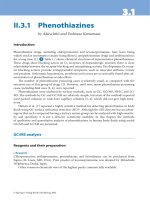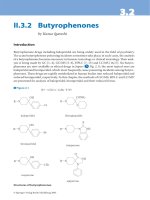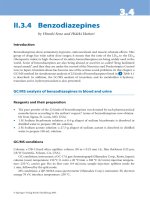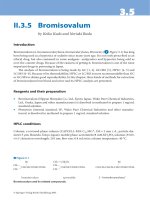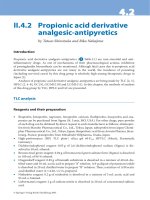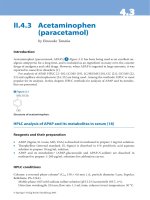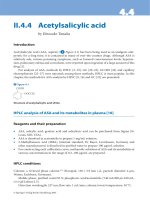Tài liệu Drugs and Poisons in Humans - A Handbook of Practical Analysis (Part 32) ppt
Bạn đang xem bản rút gọn của tài liệu. Xem và tải ngay bản đầy đủ của tài liệu tại đây (356.76 KB, 13 trang )
3.63.6
© Springer-Verlag Berlin Heidelberg 2005
II.3.6 Barbiturates
by Masaru Terada and Ritsuko Watanabe
Introduction
Barbiturates are being widely used as antiepileptics, hypnotics and anaesthetics (> Figure 6.1
and
> Table 6.1). e incidence of barbiturate poisoning cases tends to increase in Japan
(
> Figure 6.2) [1]. A majority of the barbiturate drugs is being controlled by the Narcotics
Structures of barbiturates.
⊡ Figure 6.1
302 Barbiturates
and Psychotropics Control Law in Japan; thus they are also important drugs in view of forensic
toxicology. e analysis of barbiturates in human specimens is being made by GC [2–6], GC/
MS [3, 6, 7–9], HPLC [10–13], LC/MS/MS [14], capillary electrophoresis [15] and immu-
noassays [16, 17]. In this chapter, usual methods for analysis of barbiturates by GC and HPLC
are presented.
Incidence of fatal barbiturate poisoning cases. Since fatal cases due to Vegetamin® tablets
containing phenobarbital are many, its incidence rate is also shown in this figure.
⊡ Figure 6.2
⊡ Table 6.1
Properties and doses of barbiturates
Action type Compound Route Therapeutic
dose (g)
Maximum
dose (g)
long-acting barbital
phenobarbital
phenobarbital sodium
metharbital
oral
oral
suppository
oral
0.3
0.03–0.2
0.015–0.03
0.1
0.5
0.25
0.2
Intermediate
acting
amobarbital
amobarbital sodium
oral
i.v./i. m.
0.1–0.3
0.25–0.5
0.5
short-acting pentobarbital calcium
pentobarbital sodium
secobarbital sodium
hexobarbital
oral
i.v.
i.v.
oral
0.05–0.1
0.1
0.1–0.2
0.1–0.4
0.5
0.5
0.5
ultrashort-acting
(anaesthetic)
thiopental sodium
thiamylal sodium
i.v.
i.v.
0.3–0.5
0.3–0.5 1.0
303
GC analysis [3, 6]
Reagents and their preparation
• Barbital, phenobarbital sodium, amobarbital sodium, pentobarbital sodium, secobarbital
sodium, hexobarbital, thiopental sodium and thiamylal can be purchased from Sigma
(St. Louis, MO, USA); pure powder of metharbital was donated by Dainippon Pharmaceu-
tical Co., Ltd., Osaka, Japan.
• Each barbiturate is dissolved in methanol to prepare 1 mg/mL stock standard solution and
stored at –20 °C.
• An on-column methylation reagent, 0.2 M trimethylanilium hydroxide (TMAH) (Pierce,
Rockford, IL, USA), is diluted with methanol to prepare 4 mM TMAH or 0.4 mM TMAH
solution to be used as an on-column methylation reagent (
> Figure 6.3)
a
.
• Diethyl ether
b
used is of a special grade as pure as that used for analysis of the autoxidation
value (AV) and peroxide value (POV) (Dojin Laboratories, Kumamoto, Japan). Other
organic solvents are of the highest purity commercially available.
• For calibration curves, various concentrations (4–200 ng/mL) of each barbiturate are pre-
pared by diluting each 1 mg/mL solution with methanol, and a 10-µL each is evaporated to
dryness under a stream of nitrogen, followed by addition of 0.2 mL serum.
GC conditions
Instrument: a Shimadzu GC-14A gas chromatograph (Shimadzu Corp., Kyoto, Japan).
Column: a methylsilicone fused silica wide-bore capillary column
c
( DB-1, 15 m × 0.53 mm
i. d., lm thickness 1 µm, J & W Scienti c, Folsom, CA, USA).
Column temperature: 60 °C → 8 °C/min → 250 °C; injection temperature: 250 °C
d
; carrier
gas ( ow rate): He (15 mL/min); make-up gas ( ow rate): He (30 mL/min); detectors: an FID
and a nitrogen-phosphorus detector ( NPD).
Methylation reaction of phenobarbital with TMAH.
⊡ Figure 6.3
GC analysis
304 Barbiturates
Procedure
i. A 0.2-mL volume of serum
e
, 1.3 mL distilled water, 1.0 mL of 0.2 M sodium acetate/acetic
acid bu er solution (pH 6.0) and 6.0 mL of ethyl acetate/diethyl ether (1:1, v/v)
f
are placed
in a glass centrifuge tube with a ground-in stopper.
ii. e tube is shaken vigorously for 5 min.
iii. It is centrifuged at 800 g for 5 min, and the organic layer is transferred to a glass vial with a
conical bottom.
iv. e organic extract is evaporated to dryness under a stream of nitrogen with warming at
40 °C; the residue is dissolved in 0.4 mL of 0.4 mM TMAH methanolic solution.
v. A 1–2 µL aliquot of it is injected into GC; in this method, external calibration method is
used. An external calibration curve
g
is constructed by spiking various concentrations of a
barbiturate into serum. e peak area of a peak obtained from a test specimen is applied to
the calibration curve to obtain its concentration in a specimen. For identi cation by GC/
MS, mass spectra are presented in
> Table 6.2.
⊡ Table 6.2
Mass spectra of free forms and methyl derivatives of barbiturates
Compound M. W. CI mode
(isobutane)
MH
+
EI mode
base peak
Other fragment ions
metharbital 198 155 170, 112, 169
methylmetharbital 212 213 169 184, 126, 112
allobarbital 208 167 124, 80, 141, 106, 53
methylallobarbital 236 237 195 138, 194, 110, 221
amobarbital 226 156 141, 157, 55, 98
methylamobarbital 254 255 169 184, 112, 126
pentobarbital 226 141 156, 157, 55, 98
methylpentobarbital 254 255 169 184, 112, 126
secobarbital 238 167 168, 97, 124, 55
methylsecobarbital 266 267 196 195, 181, 138, 223
hexobarbital 236 221 81, 157, 80, 79, 155, 108, 53
methylhexobarbital 250 251 235 81, 79, 169
mephobarbital 246 218 117,118,146,103
methylmephobarbital 260 261 232 117, 146, 175, 77
phenobarbital 232 204 117, 146, 161, 77, 115
methylphenobarbital 260 261 232 117, 146, 175, 77
cyclobarbital 236 207 141, 81, 79, 67
methylcyclobarbital 264 265 235 169, 79
thiamylal 254 184 168, 167
thiopental 242 172 157, 173, 97, 69
Instrument: a Shimadzu QP-1000EX GC/MS instrument: column: DB-1 (15 m × 0.25 mm i.d., film thickness 0.25 µm);
column temperature: 60° C (3 min) → 8° C/min → 290° C; injection temperature: 250° C; carrier gas (flow rate):
He (1 mL/min); electron energy: 70 eV (EI), 200 eV (CI); reagent gas: isobutane.
305
Assessment and some comments on the method
e GC analysis of barbiturates without any derivatization gives very low sensitivities, even if
a non-polar fused silica wide-bore capillary column (DB-1) is used, except for metharbital
and hexobarbital. e sensitivities of most barbiturates are enhanced several-fold to several
ten-fold by the methyl-derivatization (
> Figs. 6.4 and 6.5, and > Table 6.3). e on-column
methylation is very rapid and simple. e detection limits of the methyl-derivatives of
barbiturates were 60–90 pg on-column with an NPD and 14–19 ng on-column with an FID.
Methylmephobarbital is identical with methylphenobarbital; this means that discrimination
Gas chromatograms of free forms (A) and methyl-derivatives (B) of barbiturates using an NPD.
Amounts of barbiturates used for the free and derivatized forms were 2 and 1 ng on-column,
respectively. 1: metharbital; 2: allobarbital; 3: amobarbital; 4: pentobarbital; 5: secobarbital;
6: hexobarbital; 7: phenobarbital.
⊡ Figure 6.4
GC analysis
